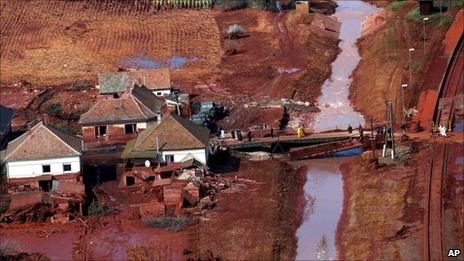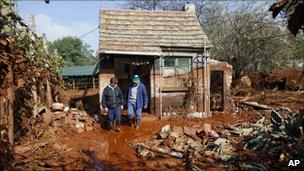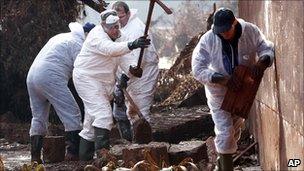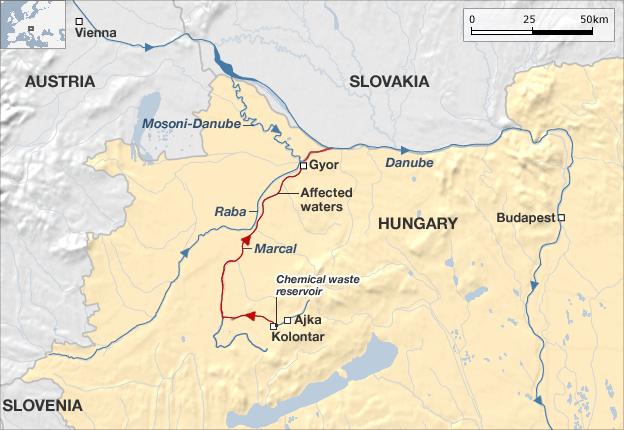Toxic sludge carpets homes in Hungary
- Published

The people of polluted Kolontar have been left homeless
In the stricken town of Devecser and the village of Kolontar the scene is one of utter devastation.
Six people were killed when the tidal wave of mud from Hungary's worst ever chemical accident hit Kolontar soon after midday on Monday.
Another person died in hospital on Friday and one person is still missing.
Rescue workers fear their bodies are buried in the deep mud of what used to be the village's fishing pond.
Emergency services are working round-the-clock to remove the worst of the toxic red sludge which has damaged houses, yards, streets and farmland.
But the dark red colour and the acrid, bitter smell are all-pervasive.
"I felt like I had arrived on planet Mars," said Balazs Tomori, an activist from the environmental group Greenpeace.
For 57-year-old Eva Varga, wading through the ruins of her home in Kolontar, the future looks bleak.
"Everything is gone, everything we had," she said.
"We used to have our own home, now we have to rely on other people."
Paint peels from the doors where it came into contact with the sludge, which still covers the floor.
Her furniture, fridge and a plant she has tended since her youth stand ankle-deep in the toxic waste.
She has just one consolation - when the disaster first struck, she managed to save her pet dog, and carry it to safety on the small hill where the village church stands.
Heavy metals
On the outskirts of Kolontar, beyond a pontoon bridge erected by the army on Tuesday night, I met a tall, middle-aged man smeared from head to foot in red mud.

The sludge swept through Kolontar like a tidal wave
He was unable to speak. His companion explained that he had been searching desperately for his elderly mother since Monday, to no avail.
It's estimated the red cloud of heavy metals is now affecting a 30km (19-mile) stretch of the River Danube.
But disaster management officials have told the BBC they are cautiously optimistic that the Danube can be saved.
"The Marcal river is dead," said Tibor Dobson, spokesman of the Hungarian Disaster Management Agency - a reference to a smaller river which flows north from the disaster area towards the Danube.
Huge quantities of gypsum and chemical fertilisers have been added to the waters of the Marcal and Raba rivers.
This action has a twin effect: to lower the dangerously high alkaline levels in the toxic red sludge which entered the river system after Monday's spill; and to bind the heavy metals in the water, where they can then be caught by dykes built in the bed of the Marcal and Raba, to prevent them flowing on to the Danube.
The distances are small. The Danube is only 45 miles (28 miles) from the village of Kolontar, the worst affect by the disaster.

Hungary has requested experts on toxic pollution be sent to help
Hungary has requested experts on toxic pollution to be sent to help the monitoring and clean-up operation.
Four days after the disaster, the clean-up operation continues round-the-clock, but the firemen, police, soldiers and volunteers are visibly tiring.
The human energy I saw at the beginning of this disaster, to rescue people and property, has dissipated, though the tasks multiply.
Warm sunshine is forecast for the next days, helping the relief effort but adding yet another danger.
As the red mud dries, it turns to dust, laced with heavy metals and a mild radioactive content. That is blown by the wind, increasing the polluted area and threatening the health of everyone.
Emergency officials are insisting that everyone wear face masks at all times.

- Published7 October 2010
- Published8 October 2010
- Published6 October 2010
- Published5 October 2010